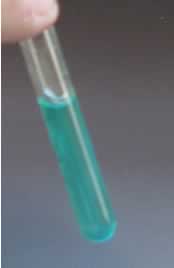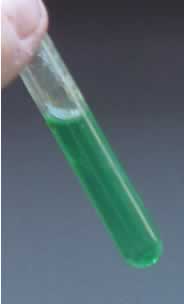Transition metal complexes
part 2
Complexes of copper
Place 3ml of 1M copper(II)sulfate solution into a small test tube. Most
of the ions in solution should be Cu(H2O)6+2
. Notice the colour of the solution (image on the right).


Now add 3ml of saturated NaCl solution and heat the mixture over a bunsen flame. Most of the ions are now CuCl4-2 . Note the colour change (image on the left).
Now cool the mixture under running water and once again notice the colour change.
What is the equilibrium expression for the reaction involving CuCl4-2 and Cu(H2O)6+2 ?
Solution - refer to your teacher for a thorough explanation.
Is the forward reaction exothermic or endothermic?
Explain. Think of the colour change that occurred when the solution
was heated.
Place 4mls of a 1M copper(II)sulfate
solution into a small test tube. Slowly add NaOH solution until a thick
precipitate of copper(II) hydroxide forms.
Click to see a 120kb movie
andnh3.jpg)
.jpg)
To the test tube with the copper(II)hydroxide precipitate, slowly add 2M ammonia solution.
The precipitate dissolves and
the mixture changes colour as shown on the left. The Copper(II)hydroxide
precipitate will dissolve as the formation of Cu(NH3)+24
is preferred.
Cu2+(aq) + 2OH-(aq) => Cu(OH)2(s)
The stability constant for
the reaction above, between copper ions and hydroxide ions, is shown
on the right. This is relatively small when compared to the stability
constant for the reaction below.
Cu2+(aq) + 4NH3(aq) => Cu(NH3)42+(aq)
2.gif)
4.gif)